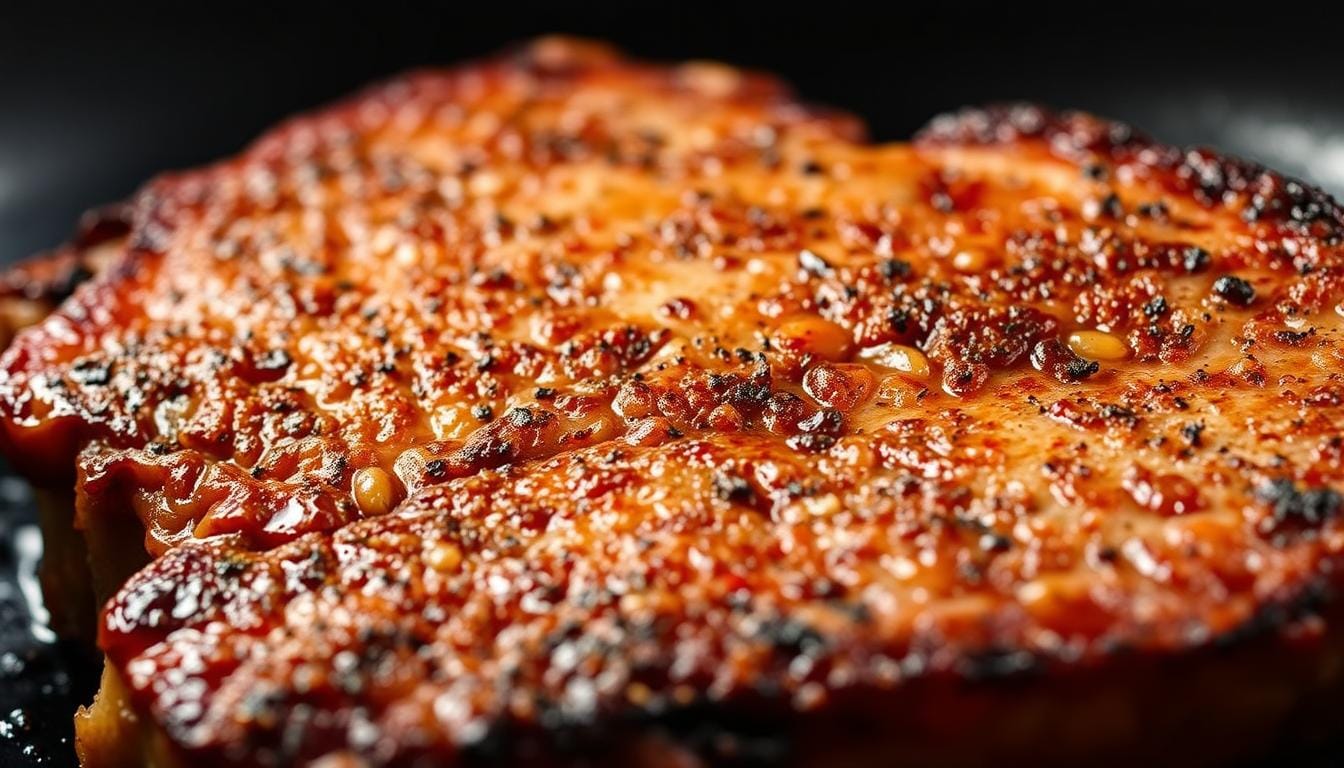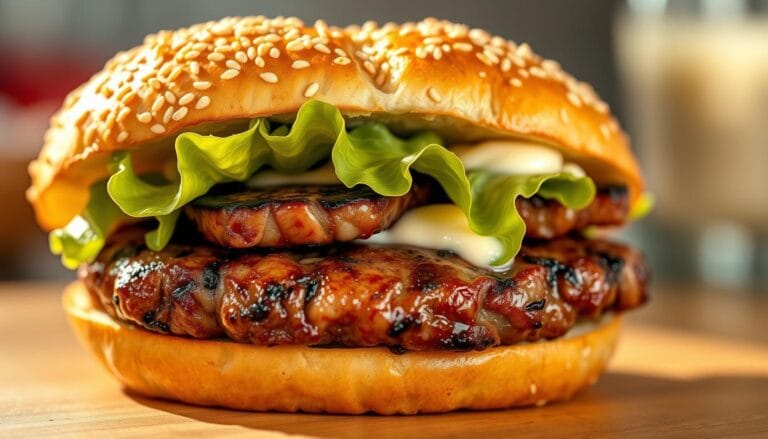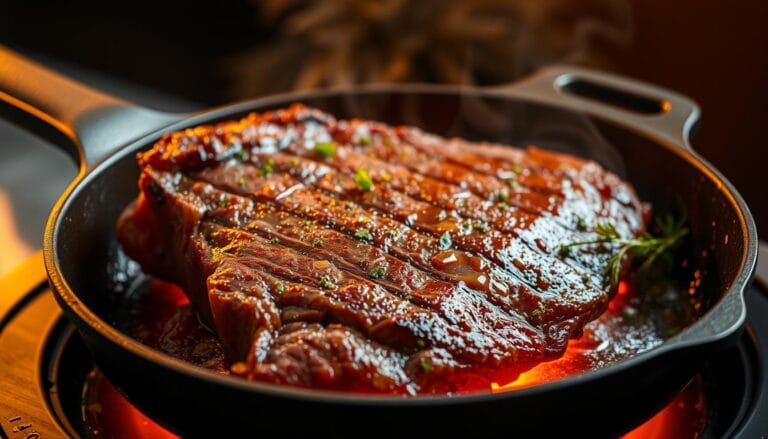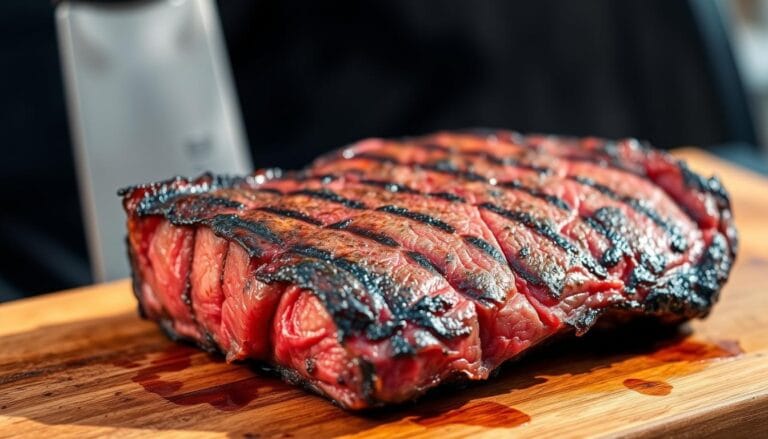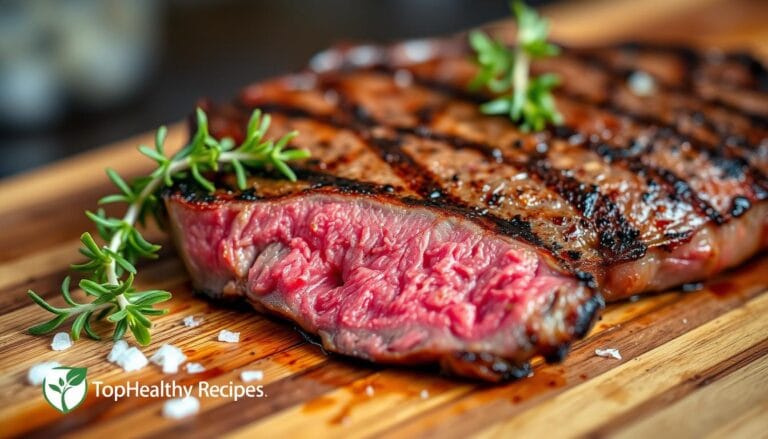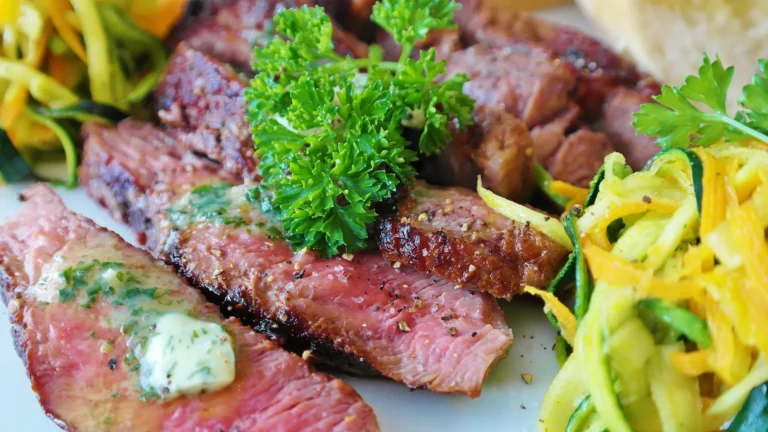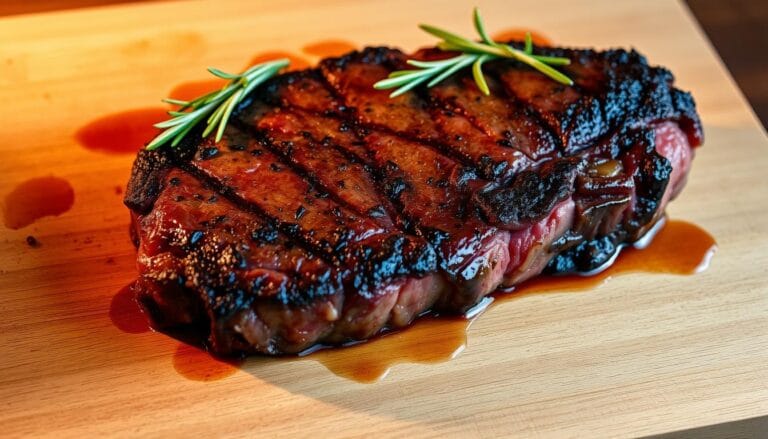Pan Fried Steak: Crispy Crust, Tender Inside – Fast & Flavorful
Table of Contents
Pan Fried Steak: Crispy Crust, Tender Inside – Fast & Flavorful
Imagine enjoying a perfectly cooked steak with a crispy, golden crust. This crust gives way to a tender, juicy interior. It’s easier than you think, even for beginners. The secret is mastering pan frying, a method that makes your steak taste like it’s from a restaurant, without needing special tools.
To make a delicious pan seared steak, choose the right cut and use simple techniques. This guide will show you how. You’ll be able to make steak that wows your family and friends every time.
Key Takeaways
- Master the technique of pan frying to achieve a crispy crust and tender interior.
- Learn how to select the right cut of steak for optimal flavor and texture.
- Discover simple preparation methods to enhance the natural flavors of the steak.
- Understand the importance of cooking temperature and timing.
- Impress your guests with restaurant-quality steak cooked in the comfort of your own home.
What is Pan Fried Steak?
Pan fried steak is a tasty dish with a crispy outside and a soft inside. It’s made by searing the steak in a hot skillet with a bit of oil. This creates a flavorful crust through a cooking process called the Maillard reaction.
Definition and Cooking Method
Pan frying is a simple way to cook steak in a skillet on your stovetop. The steak gets a crispy crust and stays juicy. To do this, heat the skillet well, add a bit of oil, and cook the steak for a few minutes on each side.
Benefits of Pan Frying
Pan frying has many advantages. It’s easy, quick, and versatile. You don’t need special gear, and it cooks in under 15 minutes. It works with many steak cuts, making it great for home cooks.
Differences from Other Cooking Methods
Pan frying is different from grilling, broiling, or sous vide. Unlike grilling or broiling, it uses the stovetop’s heat. Sous vide cooks in water at a set temperature. Here’s a quick comparison:
| Cooking Method | Heat Source | Cooking Time |
|---|---|---|
| Pan Frying | Stovetop | Less than 15 minutes |
| Grilling | Direct Flame | Variable |
| Broiling | Overhead Heat | Variable |
| Sous Vide | Temperature-Controlled Water | Variable |
Learning about pan frying helps you cook steak on the stovetop like a pro. You’ll get amazing results with just a few tools.
Selecting the Right Cut of Steak
Choosing the right cut of meat is key to a great pan-fried steak. Thickness and marbling are important. Knowing the differences in cuts helps you pick a steak that’s both tasty and tender.
Popular Cuts for Pan Frying
Some steak cuts are better for pan frying than others. Ribeye, New York strip, filet mignon, and top sirloin are top picks. Ribeye is famous for its marbling, which makes it juicy and flavorful. New York strip is loved for its balance of tenderness and taste.
How to Choose Quality Meat
Quality meat has a bright cherry-red color. Marbling, or the white fat streaks, adds flavor and juiciness. The meat should feel firm. A steak about 1-1.5 inches thick is perfect for pan frying. It gets a nice sear on the outside and stays juicy inside.
Understanding Grades of Beef
The USDA grades beef into Prime, Choice, and Select. Prime has the most marbling, making it tender and flavorful. Choice is also high quality but less marbled. Select is leaner and less tender but good for pan frying. Knowing these grades helps you choose better steak.
| USDA Grade | Marbling Level | Tenderness |
|---|---|---|
| Prime | Abundant | Very Tender |
| Choice | Moderate | Tender |
| Select | Small | Less Tender |
Strip steak is great for pan frying. It’s tender and flavorful. For more tips on cooking strip steak on the stove, check out tophealtyrecipes.com. They have detailed recipes for various steak cuts.
Essential Tools for Pan Frying
Having the right tools is key for pan frying steak. A good recipe is important, but the right equipment is essential. Let’s look at the tools you need for pan seared steak.
Skillet Types and Preferences
The type of skillet you choose is very important. Cast iron skillets are often the best for steak. They keep heat well and are non-stick when seasoned.
A good cast iron skillet is like an extension of your own hand, it becomes an integral part of your cooking process.
Other materials like stainless steel and carbon steel are also good. Stainless steel skillets are durable but may not keep heat as well. Carbon steel skillets are a good middle ground, keeping heat well and being non-stick when seasoned.
Cooking Utensils You Need
You’ll also need the right cooking utensils. Tongs are great for flipping steak without piercing it. An instant-read thermometer is key for the perfect doneness. A spatula is also essential, for flipping and basting the steak.
Choosing the Perfect Utensils
When picking utensils, think about the material and size. Look for heat-resistant and comfortable utensils. For example, tongs with silicone grips are easier to handle hot steaks.
The size of your spatula and tongs should match the steak size. For bigger steaks, bigger utensils are more practical.
Preparing Your Steak for Cooking
Getting your steak ready right is key to a tasty pan-fried steak. The steps you take before cooking can greatly affect the taste. It’s important to know how to prepare your steak properly.
Seasoning Basics
Seasoning is a basic step in preparing your steak. It’s best to season your steak with salt ideally 40 minutes before cooking or immediately before. Don’t forget to add freshly ground black pepper for a sharp flavor.
Other seasonings like garlic powder, rosemary, and thyme can also enhance your steak’s taste. They add depth and complexity.
“The art of seasoning is not just about adding flavor; it’s about making the steak taste better.” – Chef’s Insight
Marinating Options
Marinating can add extra flavor to your steak, mainly for certain cuts. Flank steak or skirt steak do well with marinating. A simple marinade can include olive oil, soy sauce, and herbs.
The marinating time can vary, but 2 to 24 hours is usually enough.
- Olive oil
- Minced garlic
- Chopped fresh herbs (like rosemary or thyme)
- Soy sauce or Worcestershire sauce
Bringing Steak to Room Temperature
It’s important to bring your steak to room temperature before cooking. This helps it cook evenly. It usually takes 30-60 minutes to do so.
After it reaches room temperature, pat it dry with paper towels. This helps get a better sear by removing excess moisture.
| Preparation Step | Importance | Timing |
|---|---|---|
| Seasoning | Enhances flavor | 40 minutes before or immediately before cooking |
| Marinating | Adds extra flavor | 2 to 24 hours before cooking |
| Bringing to Room Temperature | Ensures even cooking | 30-60 minutes before cooking |
Achieving the Perfect Sear
The secret to a mouth-watering pan-seared steak is the perfect sear. This technique takes practice and attention to detail.
Importance of Preheating the Pan
Preheating your pan is key to a perfect sear. Whether it’s a cast iron skillet or another pan, it must be hot before adding your steak. A hot pan ensures even cooking and a flavorful crust.
To test if your pan is ready, flick a few drops of water onto it. If they sizzle and evaporate quickly, your pan is hot enough. This simple method checks your pan’s heat.
Cooking Oil Options
The right cooking oil is vital for flavor and quality. Choose oils with a high smoke point like vegetable oil, avocado oil, or clarified butter. These oils can handle high temperatures without burning, giving you a clean, flavorful sear.
“The right oil can make all the difference in achieving a perfect sear. It’s not just about the flavor; it’s also about the smoke point.”
| Cooking Oil | Smoke Point | Flavor Profile |
|---|---|---|
| Vegetable Oil | 400°F – 450°F | Neutral |
| Avocado Oil | 520°F | Mild, buttery |
| Clarified Butter | 485°F | Rich, nutty |
Timing and Technique
The timing and technique of searing are critical. It’s essential not to move the steak too soon. Let it sear for a few minutes on the first side to develop a crust. The exact timing depends on the steak’s thickness and your desired doneness.
Some chefs suggest flipping the steak every 30 seconds for an even sear. This method helps cook the steak evenly and prevents too much crust on one side.
Cooking Times for Different Cuts
Cooking the perfect steak is a skill that depends on knowing the right cooking times. Whether it’s a strip steak, ribeye, or filet mignon, the cooking time varies. This is based on the cut and thickness of the steak.
Medium-Rare Timing Guidelines
For a tender and juicy steak, medium-rare is often the best choice. A 1-inch thick strip steak cooks on the stove for about 3-4 minutes per side. Here’s a table to guide you:
| Steak Thickness | Cooking Time per Side | Total Cooking Time |
|---|---|---|
| 1 inch | 3-4 minutes | 6-8 minutes |
| 1.5 inches | 5-6 minutes | 10-12 minutes |
| 2 inches | 7-8 minutes | 14-16 minutes |
When learning how to cook strip steak on stove to medium-rare, timing is just part of it. Visual cues and touch tests are also key.
Well-Done Timing Recommendations
For those who like their steak well-done, cooking it longer is necessary. A 1-inch thick steak cooks for about 5-6 minutes per side. Here’s a guide:
| Steak Thickness | Cooking Time per Side | Total Cooking Time |
|---|---|---|
| 1 inch | 5-6 minutes | 10-12 minutes |
| 1.5 inches | 7-8 minutes | 14-16 minutes |
| 2 inches | 9-10 minutes | 18-20 minutes |
When cooking a steak on the stove to well-done, a thermometer is helpful. It ensures the steak reaches a safe internal temperature.
Factors Affecting Cooking Time
Several factors can change how long your steak cooks. These include its thickness, starting temperature, pan material, and heat level. A cold steak cooks differently than a room-temperature one. Also, a cast-iron pan heats up differently than stainless steel or non-stick pans.
Knowing these factors and adjusting your cooking technique is essential. Whether you’re aiming for medium-rare or well-done, understanding these variables is key to perfecting your steak.
Tips for a Juicy Interior
A tender and juicy interior is key to a great pan-fried steak. To get this, you need to focus on several steps. These include how you prepare the steak and how you serve it.
Resting the Steak After Cooking
Letting the steak rest after cooking is very important. You should let it sit for 5-10 minutes under loose foil. This step helps the juices spread evenly throughout the meat.
When you cut into it, the juices stay inside. This keeps the steak moist and delicious.
Techniques for Juiciness
There are a few ways to make your pan-seared steak juicier. Choosing a well-marbled steak is a good start. The fat in the meat helps keep it moist.
Cooking at the right temperature is also key. A hot pan is needed for a good sear. But, it should not be so hot that it burns the outside before the inside is cooked right.
Using the butter-basting method during the last minutes of cooking can also help. It adds flavor and keeps the steak moist.
Avoiding Common Pitfalls
Mistakes can make your steak dry. Overcooking is a big one. It makes the steak lose its juices.
Flipping the steak too much can also be a problem. It stops the steak from getting a good crust. This can make the steak less juicy.
Pressing down on the steak while it’s cooking can squeeze out juices. And cutting into it too soon after cooking can spill out the juices. Knowing these mistakes can help you make a juicier pan-fried steak.
Adding Flavor with Basting
Basting can make your steak taste amazing. It involves pouring hot fat and aromatics over your steak in the last minutes. This adds rich flavors and helps cook the steak evenly.
Understanding Basting
Basting is a simple yet effective technique. It can make your best cast iron skillet steak even better. You use the hot oil and aromatics in the pan to add extra flavor.
To baste your steak, tilt the pan and spoon the melted butter mixture over it. This adds flavor and helps cook it evenly.
Timing is Everything
When cooking a steak on the stove, timing is key. Basting is best done in the last 1-2 minutes. This lets the flavors soak into the steak without overpowering it.
Keep an eye on the steak’s cooking to know when to start basting. Baste when the steak is almost cooked to your liking.
Ideal Ingredients for Basting
The ingredients for basting greatly affect the steak’s flavor. Common ones include butter, garlic cloves, fresh herbs like thyme and rosemary. You can also add shallots or lemon zest for extra taste.
Using these ingredients in the pan makes a tasty sauce. Try different mixes to find your favorite basting sauce.
Side Dishes to Pair with Pan Fried Steak
A perfectly cooked pan-fried steak needs impressive side dishes to complete the meal. Think about flavors and textures that go well with your steak. They should enhance it without overpowering it.
Classic Accompaniments
Traditional side dishes are loved for a reason. They match the rich flavor of pan-fried steak well. Some timeless choices include:
- Creamy mashed potatoes that soak up the steak’s juices
- Roasted vegetables like asparagus or Brussels sprouts, adding texture contrast
- Steakhouse-style creamed spinach, adding a rich and creamy touch
- A simple green salad with tangy vinaigrette, cutting through the steak’s richness
These classic sides are easy to make and always a crowd-pleaser. They offer a comforting contrast to the savory steak.
Creative Side Dishes
For a twist, try these creative side dishes to enhance your pan-fried steak. Consider:
- Roasted garlic cauliflower puree, a flavorful and healthier mashed potato alternative
- Crispy smashed potatoes with herbs, adding crunch and freshness
- Grilled asparagus with hollandaise sauce, a luxurious and delicious side
- Mushroom risotto, creamy and earthy, pairing well with steak’s bold flavors
These creative options can make your meal more exciting and memorable.
Beverage Suggestions
No meal is complete without the right drink. For pan-fried steak, consider these:
| Beverage Type | Recommendation | Why It Pairs Well |
|---|---|---|
| Red Wine | Cabernet Sauvignon, Malbec, Syrah | These full-bodied wines complement the steak’s rich flavors. |
| Craft Beer | Dark ales or stouts | The malty, roasted flavors of these beers pair nicely with grilled or pan-fried steak. |
| Non-Alcoholic | Iced tea or flavored sparkling water | These options cleanse the palate between bites, refreshing the dining experience. |
When learning how to cook strip steak on stove, timing your side dishes with the steak is key. It might take a few tries to get it right, so don’t give up.
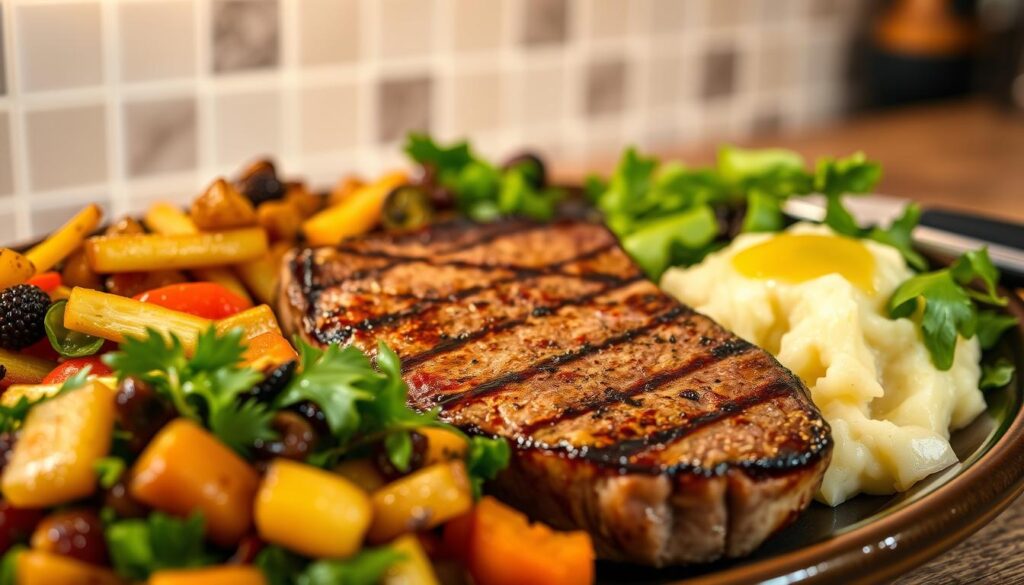
Storing Leftover Pan Fried Steak
Storing leftover pan fried steak is more than just tossing it in the fridge. It requires careful attention to keep it fresh and safe to eat.
Proper Refrigeration Techniques
To store your pan fried steak right, let it cool down to room temperature within two hours after cooking. This step is key to stop bacteria from growing.
After cooling, wrap the steak tightly in plastic wrap or aluminum foil to keep moisture in. You can also use airtight containers for storage.
It’s best to eat refrigerated steak within 3-4 days.
| Storage Method | Benefits | Duration |
|---|---|---|
| Airtight Containers | Prevents moisture loss, keeps fresh | 3-4 days |
| Plastic Wrap or Aluminum Foil | Easy to use, prevents drying out | 3-4 days |
Reheating Tips for Best Results
Reheating your pan fried steak needs some skill to get it juicy again. Try the low-and-slow oven method. Heat your oven to about 250°F and warm the steak until it’s just right.
For a crispy crust, sear the steak quickly in a hot pan after oven reheating.
Sous vide reheating is also a good choice if you have the equipment. It lets you control the temperature precisely.
Creative Ways to Use Leftovers
If you don’t want to reheat, think about turning your leftover steak into new dishes. Slice the steak thinly and mix it with greens and dressing for a cold steak salad.
Steak sandwiches are another tasty option. Top the steak with cheese, onions, and your favorite sauce.
For breakfast, chop the leftover steak and add it to a hash with potatoes and eggs. Or use it in steak tacos or pasta dishes.
By taking good care of your leftover pan fried steak, you can enjoy tasty meals beyond the first time you eat it.
Common Mistakes to Avoid
Mastering pan-frying a steak is more than just a recipe. It’s about avoiding common mistakes. Cooking a steak on the stove can go wrong if you’re not careful.
Overcooking Your Steak
One big mistake is overcooking the steak. To avoid this, look for visual cues and use touch tests and thermometers. A medium-rare steak feels soft, while a well-done steak is firm. A thermometer helps you get the right internal temperature: 130°F – 135°F for medium-rare, and 160°F or higher for well-done.
It’s important to know when to take the steak off the heat. It takes practice, so don’t get discouraged if you don’t get it right at first.
Choosing the Wrong Pan
The pan you choose matters a lot. The best cast iron skillet steak results come from its heat retention and distribution. Cast iron skillets cook the steak evenly and create a perfect crust, unlike thin, non-stick pans.
- Cast iron skillets retain heat well, ensuring a consistent cooking temperature.
- Non-stick pans can lead to uneven cooking and poor crust development.
Skipping the Seasoning
Seasoning is a must-do step. Skipping it, seasoning too early, or too late can affect the flavor. Salt is key as it brings out the steak’s natural taste. Think about the seasonings and how they handle high heat. Some herbs and spices can burn or become bitter if heated too long.
Other mistakes include cooking a cold steak, overcrowding the pan, and not preheating enough. Patience is key to cooking a steak perfectly.
Elevating Your Meal with Sauces
Sauces are key to bringing out the best in your pan-seared steak. A good sauce can enhance the steak’s natural flavors, adding depth and complexity. Whether it’s a strip steak or another cut, the right sauce makes a big difference.
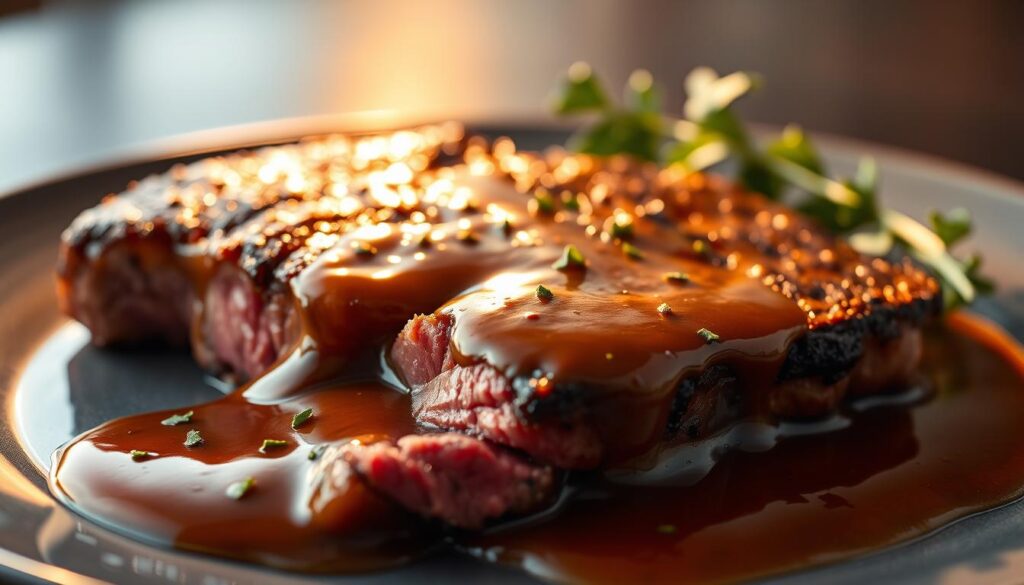
Homemade Sauce Ideas
Making your own sauces lets you customize the flavors. Classic choices include red wine reduction, peppercorn sauce, and béarnaise. These sauces not only add flavor but also make your dish look great. For example, a red wine reduction is made by simmering red wine until it’s almost syrupy. Then, mix it with beef broth and butter for a rich, savory sauce.
Peppercorn sauce is another favorite, made by cooking peppercorns in cream for a luxurious flavor. For something simpler, try a compound butter with softened butter, herbs, and spices. It melts beautifully over hot steak.
Quick Sauce Recipes
For when you’re in a hurry, a quick sauce works just as well. You can make a pan sauce using the flavorful fond left in your skillet. Add a bit of wine or stock, scrape up the browned bits, and finish with butter for a silky texture. This method saves time and captures the essence of your steak.
- Deglaze the pan with wine or stock.
- Scrape up the browned bits.
- Reduce the liquid slightly.
- Finish with butter for a rich sauce.
Complementary Store-Bought Options
When you’re short on time, high-quality store-bought sauces can be a good choice. Look for brands that offer rich, flavorful options that complement your steak without overpowering it. Choose brands that specialize in artisanal sauces made with natural ingredients.
“The right sauce can turn a simple steak into a culinary masterpiece.”
When picking a store-bought sauce, think about the type of steak and its doneness. For example, a strip steak cooked to medium-rare pairs well with a light, herb-infused sauce. A well-done steak might do better with a heartier, more robust sauce.
Conclusion: Perfecting Your Pan Fried Steak Skills
Learning to pan fry steak is a journey. It takes technique, patience, and creativity. You’ve learned the key steps to cook a perfect steak, from choosing the right cut to serving.
Key Takeaways
You’ve learned the basics. Preheat your pan, season your steak, and cook it to the right temperature. You’ve also found out how to get a tender inside and a crispy outside.
Experimenting with Flavor
Once you’re more confident, try new seasonings, marinades, and basting ingredients. This lets you create unique flavors. It’s your chance to make the recipe your own, matching it to your taste.
Enjoy the Process
Cooking pan fried steak is more than just the end result. It’s about enjoying the journey. With practice, you’ll find your own way to cook a steak on the stove. So, take your time, enjoy the process, and savor the delicious steak you make.
FAQ
What is the best type of pan for cooking steak?
How do I achieve a perfect sear on my steak?
How long should I cook my steak on the stove?
What’s the best way to season a steak before pan frying?
Should I marinate my steak before pan frying?
How do I keep my steak juicy after cooking?
Can I reheat leftover pan-fried steak?
What are some creative ways to use leftover steak?
What are common mistakes to avoid when cooking steak on the stove?
How can I elevate my pan-fried steak with sauces?
For more cooking tips, stay connected with us. We also recommend the cookbook Skinnytaste Simple: Easy, Healthy Recipes with 7 Ingredients or Fewer
For more Recipes about Steak ?
Did You try our recipe ?
There are no reviews yet. Be the first one to write one.
